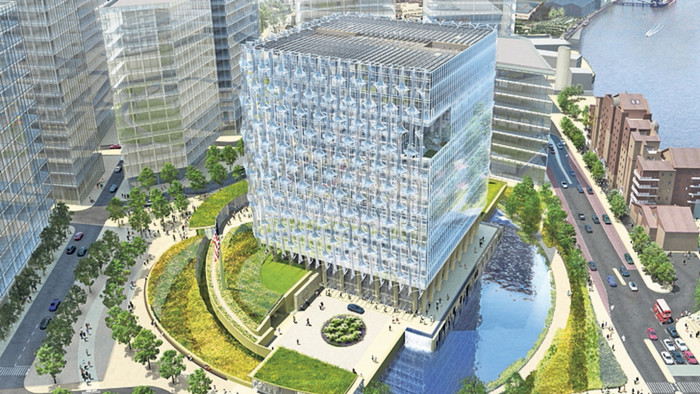Safety obsession creates risk of ‘fortress’ cities

Roula Khalaf, Editor of the FT, selects her favourite stories in this weekly newsletter.
When the new US embassy in London, just along the river Thames from Battersea power station, opens its doors in late 2016, it will be one of the most secure buildings in Britain.
Architects KieranTimberlake trumpet its high-spec, high-security features: “In contrast to high perimeter walls and fences, security requirements are achieved through landscape design — such as the large pond, low garden walls with bench seating, and differences in elevation that create natural, unobtrusive barriers.”
The embassy’s own description of the building as “modern, welcoming, safe” sums up the challenge planners have in reconciling the conflicting desires for security and openness in contemporary urban environments.
But while the embassy design is a far cry from the more obviously militarised current site in Grosvenor Square, critics say it is emblematic of a broader trend. The past decade, has seen highly defended spaces spring up across towns and cities, creating what some describe as a hostile “fortresslike” environment.
The new US embassy is “like a Norman castle,” says Stephen Graham, professor of cities and society at Newcastle University. “It even has a moat and is set back, with empty space to protect it from truck bombs or blast,” he adds. “This is the logic of what an antiterrorist city would look like.”
Such fortified buildings are one aspect of a trend that has introduced several forms of “defensible space” into the landscape. A public outcry greeted the “anti-homeless” spikes that were spotted fixed into the ground outside a private apartment block in south London’s Southwark Bridge Road last summer.
Boris Johnson, London’s mayor, called them “ugly, self-defeating and stupid” and they were later removed.
Retailers have courted controversy by installing so-called “Mosquito” alarms, which emit a high-pitched sound heard only by young people and babies, to discourage loitering. In New York, spiked coverings have been attached to fire hydrants to prevent people sitting on them. Other examples include sloped bus shelter seats, park benches you cannot lie down on and the Camden bench, designed to deter skateboarders.
The term “defensible space” was coined by the US architect Oscar Newman in the 1970s. This spawned an industry based on the principles of Crime Prevention through Environmental Design (CPTED), ideas that journeyed across the Atlantic and have a far-reaching influence on urban policy through, for example, the UK police’s initiative, Secured by Design.
Prof Graham comments: “We are redesigning the city so that anyone who doesn’t move is deemed a threat, which includes someone who is pregnant, who has young kids or a disability. I can’t deny there are attacks and dangers and vulnerabilities, but sometimes those are exaggerated and the terrorist threat becomes a massive obsession.”
Phoebe Boulton Jaggi, a student at the London College of Communication who has researched antisocial street furniture says cities become “more liveable for consumers and less liveable for other people”. While architects may attract support for building defences into potential targets such as the US embassy, critics object to fortress security levels grafted on to other public buildings, including schools, hospitals and housing. These often incorporate features such as high-perimeter fencing, barbed wire and CCTV cameras.
“Secured by Design has become the template for all new development today,” says Anna Minton, author of Ground Control and reader in architecture at the University of East London. The threat of terrorism has become the “justification for ever-increasing security” as part of the daily environment, she adds.
Secured by Design, wholly-owned by the Association of Chief Police Officers, was formed in 1989. It supports the concept of “designing out crime”, with, for example, specially constructed doors and fencing, which, it says, can reduce burglary by 75 per cent.
“Security measures can be invisible,” says Jon Cole, Secured by Design’s national operations manager. “If you build in security at the outset, then the building will generally be far more aesthetically pleasing.”
There has been something of a reaction to hyper-securitised, exclusive city spaces. London’s Oxford Circus is an example of the European idea of “shared space”, which focuses on improving traffic safety through the removal of barriers, roundabouts and even traffic lights.
In the US, organisations such as San Francisco Rebar, a landscape design group, are influencing the debate on public space. Meanwhile, in Hamburg, designer Oliver Schau has used yellow drainage pipes to create impromptu “guerrilla seating” in urban areas.
In Canada, RainCity Housing, an independent charity that helps the homeless, installed a roofed bench in the city to provide shelter to street sleepers, in contrast to the anti-homeless spikes that have made their appearance on London’s streets.
Prof Graham thinks the debate will intensify. “Raising awareness of what is going on is a challenge,” he says. “It is such a massive thing for people to get their heads round.”
Comments